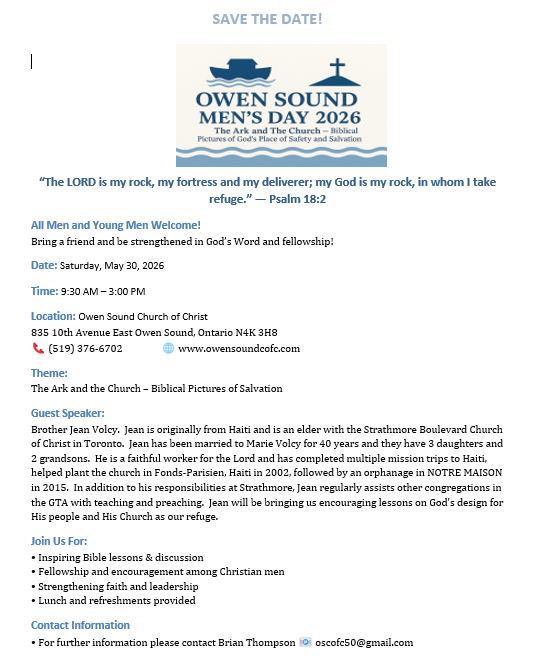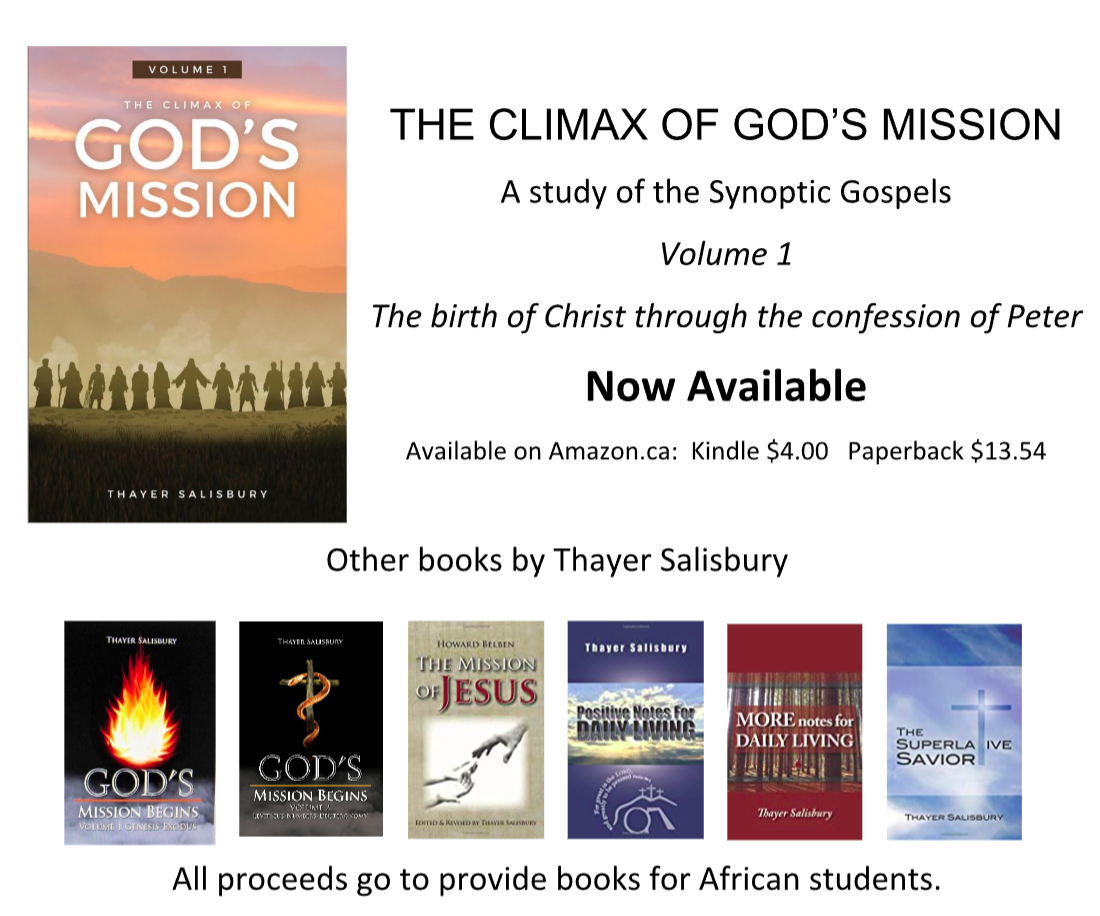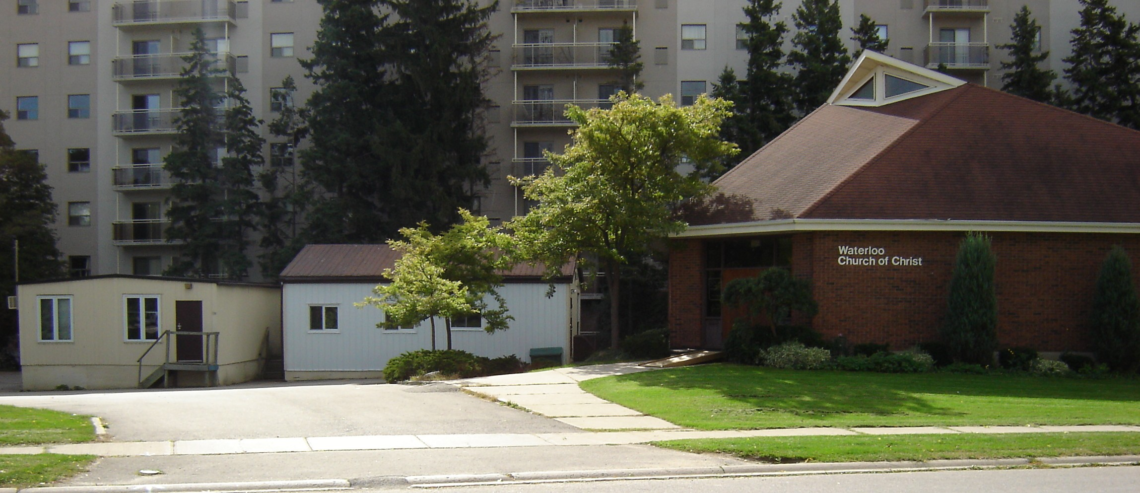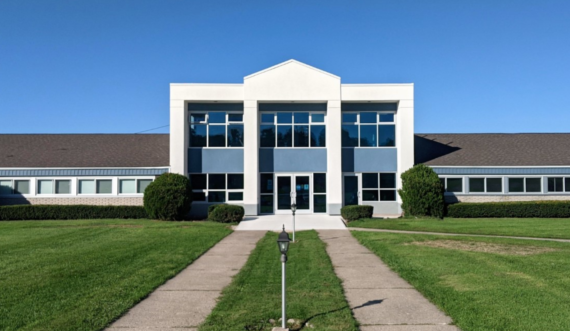The following is the text of a presentation made to the Canadian Churches of Christ Historical Society on Saturday, Aug 20, 2022.
Great Lakes has a 7-decade long history. This is 7 decades of helping form students into the image of Christ. In this presentation I will focus on institutional issues such as administrative leadership and campus development. This is not the most important part of the story. By way of example, I recently attended a funeral, which one might have been forgiven for confusing with a Great Lakes’ Alumni gathering. The relationships begun, whether with each other or with God are the true story of Christian Education everywhere. Great Lakes is no exception. This important aspect held true whether the institution was going through its low moments or highly exciting developments. I would hate for us to forget this important truth as we look at developments in the history of the endeavour. Many lives have been deeply impacted through the ministry, and that is the most vital thing about 70 years of service to God.
The source of my information for the first 50 years, comes from The Great Lakes Story: Building Foundations of Faith published in 2002. (For those interested, a copy of the book can be obtained by contacting Great Lakes Christian College)







As in other parts of Canada, Ontario churches hosted Bible School sessions to strengthen the church. From 1902-1916 the Beamsville Bible School operated from the brick church building located on Queen St., just up the hill from King St. Many others lasting one or two months long, such as one taught by Cecil Bailey in Thessalon in 1936 were a part of the fabric of Churches of Christ. In 1937 the Johnstone family donated 10 acres to begin Omagh Bible School. Many who attended Omagh Bible School gained a vision for Christian Service. A 1945 picture of 45 students, nearly half of whom went on to southern Christian Colleges.
By 1950 over 100 young people from churches of Christ were attending Christian Schools in the States.
Churches benefited from the presence of those who had been a part of these earlier training efforts, so the calls for a Christian College here were becoming more vocal. These early training efforts helped form “the stream of influence that culminated in Great Lakes Christian College.”
In Feb. 1950 church members took a winter holiday to attend a 2-week lectureship in Beamsville on the twin themes, “The New Testament Church” and “Christian Education and Recreation.” This lectureship concluded with a meeting at the Beamsville Church of Christ on February 17 about “A College Proposed for Ontario.” Things proceeded quickly after that.
On May 5, a second general meeting with respect to the establishment of a Christian College was held at the Sandford Ave Church of Christ in Hamilton attended by representatives from Ontario and New York State. Bruce Merritt reported in the Gospel Herald that it was unanimously agreed that actions should be taken to establish a Christian College as soon as possible.
Letters patent and incorporation application was made May 5, 1950. On August 22, 1950, Great Lakes Christian College was created under the authority of the Lieutenant Governor of Ontario. Under the provisions of the Letters Patent, the foundation charity, Great Lakes Christian College, could elect to “establish, maintain and operate religious schools, meetings, lectures, libraries and camps and to print, publish, sell and distribute literature pertaining thereto.”
The first board began with Oliver Tallman, Bruce Merritt, Fred Smart, John Whitfield, Stanley McInery and Albert Jones. John Williams was added shortly thereafter. They also made up the initial corporation membership. Rosalie Jones served as secretary.
The proposed name, Ontario Christian College was denied by the authorities as it was too close to an existing institution.
Oliver Tallman and George Johnson had not only been leading the charge for a new school, but Tallman has also been a seeking suitable location in the Golden Horseshoe. The Senator Gibson estate of 12 3/4 acres was chosen.
By the fall of 1952 the property was purchased, and the church community had banded together with many individuals volunteering their talents to make renovations and prepare for the new school.
The big day to start finally came. Opening ceremonies were held Sept. 8, 1952. The local newspaper reported that several hundred people crowded into the chapel (the former dining room of the Gibson estate, now the common room of Perry Hall) for the event. There were 14 students in grades 9-10. The operation began based on the faith of those who envisioned the school as well as that of its founding board, President CG McPhee, Principal Bruce Merritt, and full-time teacher, Eugene Perry and the other teachers and staff who volunteered. These volunteers included the wives of these men. Faith was also evidenced by the families who enrolled their children in this new endeavour.
The paid staff received subsistence salaries. The men agreed that when they were paid for preaching by a church, they would take enough to cover travel expenses, then subtract the balance from their salaries.
The plan was to add another grade each year until the curriculum included grade 13. The Bible department would include a 2-year program that was transferable to Christian Colleges in the States. The Bible department began with 6-10 week evening classes (I believe on Monday and Thursday evenings) in the winters. Eugene Perry indicated that over 50 came from the region for these classes.
An annual Bible Lectureship began in that first year and continued to be held on campus until 2017.
Grade 13 and a one year one-year commercial class were added in 1956-57 school year. As well the 2-year post secondary Bible program became part of the school day.
The original property included 3 buildings that were transformed into dormitory, classroom and cafeteria spaces. In the 50s the Snure house across the road was added for teacher apartments. This former home of the Beam family, for whom the town was named was sold in the 1980s. In 1957 a barn was converted into classroom and student centre space. This is now as Huron Hall.
Late in the 1950s a fund-raising initiative was suggested by John Stevens, President of Abilene Christian College, known as Pay-For-A-Day. People were sought to donate the $65 difference between the operational cost of $151 and the $86 per day that was covered by fees.
As the decade of the 50s began, the school was but a dream. It had developed into a school of 77 students, 36 of whom were living in dormitories with classes, clubs, sports teams, chorus, and drama activities.
CG McPhee, the first president served from 1952-54. Bruce Merritt filled the role from 1954-1961.
1960s
Geoffrey Ellis took the helm as President in 1961. His vision and untiring efforts lead to the expansion of the campus. Student attendance hovered around the 100 mark through much of the 1960s but grew to almost 150 in 1969.
The high school program had continued to add activities for students. These included a spiritual emphasis club for boys, (Koinonea), and the Girls’ Religious Club. There were lots of sports activities with competition in the Ontario Athletic Association of Christian Schools (OAACS) of which Great Lakes had been a charter member in the 50s. Geoffrey Ellis had served as the first chairman. The gym at Beamsville Secondary School was rented one night each week for practices and games were also held there. Students participated in hockey, basketball, soccer, track and field, and softball for a time. Academic clubs had also taken hold. The drama club known as footlights club not only put on a dramatic performance each year in a rented facility, but also took part in competition with other schools in the area. Friday night social activities were regular events.
Early in the 60s the WAVES (Women’s Association for Vital Educational Support) was started. The Waves have truly been and continue to be a vital support through their fund-raising activities and serving at many school functions.
An annual Youth Rally began in 1961 which continued each year up until the pandemic of 2020. It will resume next year.
Major upgrades to the campus in the 60s included: In 1962,Two classrooms were built on the north side of Huron Hall. The building had housed classrooms upstairs and a student centre downstairs.
College Hall opened during the 1964-5 school year. Later it was appropriately named Ellis Hall in honour of Geoffrey and Doreen. A cafetorium wing was added for the 1970 school year.
Roy Merritt moved to Beamsville in 1968 to give leadership to the Bible program. It was then known as the School of Bible and Missions and became known as the Faculty of Bible and Missions in 1969. The FBM sponsored its first annual Bible Teachers Workshop that year. These continued until the early 1990s.
GL started the decade with 175 students, including 11 in FBM
In the 1960s there had been a few students from outside North America who attended one of the school programs. These, I believe, without exception had church connections. Beginning in either 1969 or 1970 students with no church connection began applying from Hong Kong. These, and other international students were seeking a route into Canadian Universities have had an increasing influence on the school, and certainly in more recent years the school has come to have an increased spiritual influence on these youth. Early on, the international students began to pay a surcharge, and the high school program became addicted to their money.
Early 70s were tough financial times with growing debt. Perhaps that statement could be made of each decade of the school’s existence. I have heard it said at many times and in many ways, that the school should not still be here, but it has continued against all odds.
1971 saw a 3-year plan for development in which the annual fund and the capital fund were merged, with a policy that the annual fund needs would be met first and the balance made available for the capital improvement of the college.
The first generation of supporters of the school were a dedicated group. Many projects happened on a shoestring budget with both bartering and many donations in kind.
For example,the school’s athletic field was created when an agreement with Beamsville Tile Company allowed them to take clay from the field. In exchange, they agreed to leave a level field by removing up to ten feet of clay from the south end and building up the north end by about three feet. They were to leave a drainage slope on the surface. A Quonset Hut was erected to provide a temporary indoor athletic facility so the school’s athletic curriculum would continue to be recognized by the Ministry of Education. The task was accomplished as a community effort. Lewis Kent donated lumber for the ends of the building and a team of volunteers bolted the curved roof sections together and built the ends of the building. Two tennis courts and a rubberized track around the athletic field, donated by Doug and June Tallman completed the new athletic facilities. Students had organized a walk-a-thon which raised $12,000 of the $15,000 that the school had invested in these facilities. By some estimates this was a $400,000 improvement.
Max Mowrer came as Principal the fall of 1971. Formerly he had served as the high school principal at Ibaraki Christian College in Japan.
Geoffrey Ellis’ contribution to Great Lakes was recognized in part by his being awarded an Honorary Doctor of Laws degree by Harding College. In the citation Dr. Ganus said in part, “He has exhibited great character and ability, has worked so diligently and successfully, and has accomplished much for the cause of Christ and Christian Education in Canada.”
In 1974 Harding bestowed the same recognition to Eugene Perry in recognition of 25 years of service to churches of Christ in Ontario, to GLCC and to scholarly pursuits. Eugene had served as Principal from 1957-1971. As well, from 1953 until going to Zambia in 1974, Eugene also served as the editor and publisher of the Gospel Herald periodical and operated the Gospel Herald Bookstore from his house.
SBM Seminars became a frequent and welcomed addition to campus life. An example of this was a 5-day apologetics seminar themed, “The Creation of Life” featuring Douglas Dean from Pepperdine College, Don England from Harding College and Virgil Trout from Oklahoma City.
Dr. Eleanor Robinson of Toronto became the first woman to serve as a board director in 1972.
Students had started raising funds for capital improvements through a walk-a-thon, which was changed to a Work-a-thon in 1973. It is now known as Community Service Day since the emphasis changed in the early 2000s from doing tasks about the campus to helping with community projects.
As another step toward the original desire for a college serving the Great Lakes basin, circa 1973, an administrative change was made when Roy Merritt became Dean of the College division. The students in grade 13 and FBM program came under the college umbrella. They had their own student council, chapel and Bible classes.
1976 saw the FBM offer its first off campus extension Bible Class at the Bayview Church of Christ building in Toronto. This was an attempt to expand the reach and the value of Bible education in Churches of Christ.
The first endowment fund was established with a gift form Hannah and Norma Smart.
In May of 1977 the Tallman Auditorium Gymnasium opened. In the fall of that year Oliver Tallman resigned as chairman of the board, a position he had held for 27 years (since the school’s inception). Max Craddock became the second Chairman of the Board. Oliver would continue to serve on the board until 1988 resigning after 38 consecutive years of service.
1979 saw a renewed effort to enhance the original vision of a college as the board of directors and administration decided to concentrate on a post-12 program, as distinguished from grade 9-12 high school program. The School of Arts and Science program, normally referred to as a junior college in the States, was an effort to provide a two-year educational experience. Its purposes were identified by Walter Dale as including: “a better base for Christian young people with more Bible and ministry training to enter the non-Christian world of the universities in Ontario, the challenges of the non-Christian society, and the work of the local church; the opportunity for a year or two of extended education and preparation for the student who did not plan on further college education, and a less expensive junior college education for those planning to attend a senior Christian College in the States.”
McPhee Hall expansion to better house the school began in 79 with the official opening in 1981.
1n fall of 1980 the school opened with 202 students, the highest in history. Much credit for this goes to the work of David Carruthers, and he would say, the tools he had at his disposal. It was a time of optimism.
Events like the Annual Bible Lectureship and the Bible Teachers Workshop reached their peak in 70s and 80s having attendance numbers in the 400-500 range on several occasions. This was a great service to churches on both sides of the border.
In 1984 Geoffrey Ellis resigned after 30 years service, 23 as President. The yearbook of 1984 was dedicated to him and made these observations, “There were 97 students in 1961 and the campus boasted 5 buildings and 19 acres of land. In 1983, we have seen enrolments of more than 200, and the campus now boasts 10 buildings, including three homes, one apartment building, and a centre for educational use which is amongst the best the OAACS.” The campus had 60 acres of prime land extending from King St. to John St.
Roy Merritt founding dean of Faculty of Bible and Missions turned that role over to Edwin Broadus in 1980. Efforts to promote the FBM and expand its service to the church included a Faith Experience Year, Restoration Tours, Short Courses, and off-site courses. From 1983 to 1986 a Slavic Studies program directed by Rick Pinczuk was operated in conjunction with the Southern Hills church in Shreveport, Louisiana.
Broadus then became president in 1984 and served in that role until July 1990.
In 1987, under Edwin Broadus’ leadership, Great Lakes Christian College applied for special legislation that would give the ability to grant degrees. Under the provisions of the Degree Granting Act, a new Bible College had to be incorporated. A Private Member’s Bill, Bill Pr5, also known as the Charter, constitutes the enabling legislation that created the new corporation.
During the process, one of the issues needing to be dealt with was meeting minimum standards for assets that the proposed Bible College would hold. A motion passed at the June 14, 1986 meeting of the board of directors would remove this roadblock to the passage of Bill Pr. 5, (referred to as the charter from now on) and at the same time have a significant effect on what was about to become two different schools.
“Moved by John Whitfield and seconded by Charles Whitfield that the Board approve in principle the transfer of assets from GLCC to the proposed GL Bible College in the amount of $300,000 Subject to the condition that in the case of dissolution of G.L. Bible College these assets revert to GLCC.”
As a result, assets including 1) endowment funds that had been given for the FBM/College program, 2) library books and 3) McPhee Hall (the building only, with no land) were now owned by the Bible College.
Two weeks later, on June 29, 1987 the Legislature of the Province of Ontario granted Royal Assent to Bill PR5. This Private Members bill which had been presented by Philip Andrews, our local MPP created Great Lakes Bible College, with the power to grant degrees of Bachelor of Theology and Bachelor of Religious Education.
I believe I have heard that this was the final day the legislature sat. In an election that September both Andrews and the Conservative government were defeated. Had it not passed that day, it would not have happened. The significance cannot be overstated. I believe no charters to operate a Bible College has been granted since that time.
According to the charter, the incorporating board of Trustees of Great Lakes Bible College were Douglas Tallman, Roy Williams, Ron Knight, Bethel Bailey, John Colyn, Max Craddock, Arthur Fleming, Valerie Lane, Wayne Page, Maurice Pickard, Malcolm Porter, John Smiley, Oliver Tallman, and Charles Whitfield.
The incorporating board of Great Lakes Bible College was the board of GLCC. For some years the board had operated with a college committee focusing on the needs of the college program. The decision was made to maintain concurrent boards and corporations. The leadership came from a President who served both schools. The members would deal with the concerns of each corporation separately. This arrangement continued until 1996.
The recession of the late 1980s brought special challenges to the Great Lakes Ministry. The move to eliminate Grade 13 in 1988-89 also brought special challenges to the junior college concept.
Tom Clark became President Aug 1, 1990, being the first alumnus to serve in that capacity. There was an immediate financial crisis facing the school. Tom made some difficult staffing decisions and made changes to procedures in an effort to streamline services and cut costs. Fund-raising efforts were attempted to overcome deficits and the effect of growing indebtedness. At the same time the enrolment was declining each year despite having a full time student recruiter back at the school. According to GLCC Reports, Sept. 1993, staffing levels in administration, teaching and support staff was the lowest in 3 decades.
Nevertheless, the school found itself in a crisis by June of 1993. The financial operation was facing a $200,000 deficit. Bank financing was at it’s limit. Accounts payable reached the $150,000 range and suppliers were constantly calling for payment. The school was in the unfortunate position of finishing off each school year by spending prepayments from international students for the following year. This source of funds was just not there that year. In the face of impending doom, the board made the bold decision to open for another year in its June 5 meeting. My recollection of the day has Doug Tallman passionately stating that we should use up all of our equity trying to fulfil our mission if that is what it took rather than giving in. The board also decided to become much more involved in the day-to-day operation of the school. The board finance committee was tasked with investigating the sale of or borrowing against the large house on the southeast corner of the campus. Two special board meeting were planned for June and July. The final meeting concluded with the President’s role being eliminated and a board committee set to operate the school.
The young Bible College had seen Alexander Best, Michael Toby, and Bill Wheeler graduate with bachelor’s degrees in 1992. The academic leadership of the college had been provided by David McMillan whose two terms sandwiched a 2-year period when Harold Parker had served as the dean. In 1993 Dave resigned as the Dean of the Bible College and also recommended that the college be closed due to difficulty of finding suitable students and mounting financial difficulties. As other teachers were part-time and no students had been recruited for the fall, the board decided to suspend the offering of classes by the Bible College. Volunteers would continue to organize the annual Lectureships and other community programs that had fallen under the direction of the Bible College.
As word of the crisis spread in the community funds began pouring in so that by July 31, the deficit for the operation was down to $90,000.
For a 2-year period a school that would become Heritage Christian School in Jordan rented McPhee hall for its k-12 program. This provided much needed income.
Through the 1993-94 school year Fraser Mowat, Steve Courson and Lawrence Whitfield took on the administrative duties. When it became obvious that the board volunteers would burn out if the pace were kept, the board appointed Brian Boden, Steve Courson, Art Ford and Fraser Mowat as an administrative team beginning in the fall of 1994. That structure continued until Art Ford was appointed President in 1996.
Reactivation of Great Lakes Bible College

In 1995, a proposal came forward to resume classes of Great Lakes Bible College and relocate them to Waterloo. Waterloo chosen due to its proximity to major educational institutions and its larger population base. There was a desire to see the Bible College as more than a part of the high school. Geoffrey Ellis was ready to serve as volunteer Principal of the College for 5 years. The reactivation came about in 1996.
The reactivation of the Bible College presented a lot of challenges. Students needed to be recruited. Teachers needed to be found. Administrative structures needed to change. Resistance to change needed to be overcome. We had to come to grips with the fact that we had two separate institutions. I think it is fair to say that most of us still saw a Great Lakes school with two divisions or departments. This was really against the letter and the spirit of the charter, and the Corporations Act of Ontario.
It was decided that the reconstituted Bible College should have a dedicated board as our charter called for. To this point in time the same board members served each school.
The challenge was to keep the two schools on a unified path. To manage this outcome, a joint operating agreement was entered by the two corporations. As a part of that agreement, it was decided that there would be one person serving as President of both schools. there would be three people who would serve on both boards. In an attempt to keep the corporation membership the same, the boards entered an arrangement whereby the membership fee of $x would covered their choice of membership in one or the other corporation or both. Also significant in that agreement was an arrangement whereby the Bible College contracted with the Christian College for financial and administrative services. This included paying 10% of the President’s salary.
To utilize McPhee Hall, Great Lakes Christian Preschool was created under the direction of Barb Smith. It was hoped that this effort would provide both additional funding and provide a service to the community. The Christian College paid the Bible College a nominal rental fee and agreed to cover all maintenance of McPhee Hall as recognition of it owning the building.
The school year for the reactivated Bible College began in the Waterloo Church of Christ’s building with two full time students and members of congregations in the Waterloo area also taking a class or two. Dave Knutson who had taught in the FBM from 1980-86 before becoming self-employed in St. Catharines for a few years agreed to teach two days a week alongside Geoffrey. Jeopardy came a few weeks into the first semester when half of the full time students withdrew. Unphased, the program continued.
The last half of the 90s saw 5 consecutive years of balanced operations for the Christian College as well as improvements to safety concerns in dormitories and upgrades to computers (an unending effort, it appears). While this was a great blessing, the financial operations continued to be quite vulnerable.
The Christian College began the 2000s with a 1.5 million dollar capital campaign that resulted in a renovation of Georgian Hall, which was renamed Hotchkiss Hall, the construction of a central driveway into the campus, a new dorm for boys that included a student centre and remodelling Ellis Hall for more classroom space. These capital projects were completed in 2004
A plan was also developed to bring the high school teachers’ salaries from an average of 62-67% of public salaries to a never before dreamed of 80% of public sector teachers in order to maintain high quality staff.
The first graduation event of the revitalized Bible College in 2001 saw Eileen Dale and Mike McCabe receive a Certificate of Biblical Studies (1-year), Jamie Azzoparde and Javier Cuarezma receive a Diploma of Biblical Studies (2-year), Gary Nutt with a Bachelor of Religious Education.
As Geoffrey Ellis had completed his 5-year commitment, Dave Knutson became the second dean of the reactivated school.
The Waterloo congregation moved to a new building on Glenelm Cres. in Waterloo in 2002. The Bible College was able to rent space there that included one portable for use as a library and shared use of the other portable for classroom and office space as well as privileges in the church building.
Writing in the Great Lakes Bible College Newsletter (Winter 2002, Vol. 6 No. 3) Dave Knutson articulated the goal of the training provided.
“…it is not our goal to provide ‘all of the answers’ or for that matter, even to raise ‘all of the questions.’ Instead, we mean to equip our students for a lifetime of growth in matters pertaining to God and his Word. Our goal is to graduate candidates who have a broad base of biblical knowledge and the ability to think for themselves. At the same time, we encourage and support personal spiritual growth and meaningful service to the church.”
I believe this has consistently been the goal of the Bible College throughout it various incarnations in the past 70 years.
Both schools continued to serve their students well, but both struggled to reach enrolment targets. Through the 1990s and 2000s, families in our churches were resisting sending their children away from home to high school. While a few church families moved to Beamsville for their children to attend Great Lakes, the school was attracting more students from other churches in the locality. The numbers and percentage of students from offshore continued to grow.
While the Bible College sought to broaden its base of students by offering a “Gateway Year” of Bible study between high school and university, the concept was never broadly embraced. At the same time it was difficult to find significant numbers of those interested in full time studies and/or full time ministry. Short courses were appreciated by ministers and other church leaders who sought ongoing learning opportunities.
In 2006 Art Ford resigned as President and Don Rose was appointed to take on that role. Don is the third alumnus to serve in that capacity.
The Christian College board entered a restructuring process in 2011 that saw Don’s role renamed to Chief Operating Officer. While the role didn’t change significantly it was decided that he should serve only the Christian College. It was hoped, in part that the new title would overcome any confusion with having two presidents. These changes took effect in 2012. The school also began to market itself as Great Lakes Christian High School.
Brian Boden had assumed the role of Principal in 1994, and continued in that role until 2014. In 2016 Brian ended 46 years as an employee of the school.
Don accepted the dual role of Principal and CAO from 2014 until 2018 when Kerri Kennedy became the 9th person, and first woman to serve as high school principal.
A capital campaign to celebrate 60 years of service replaced the roof of the gym and installed thermal heating. Vision 2020, which took a year longer to complete than planned made Ellis Hall fully accessible and included other changes within Ellis Hall as well as the attractive facade we see today. The Clean Air campaign has enabled air circulation and filtering systems that allow micro-climate controls for each classroom.
Enrolment for the past ten years has averaged 118. Last year and this upcoming year will be between 100-110. Due to a school-student-parent software interface that had been developed, and to the dedication of the teaching staff, GL was able to transition smoothly to the remote learning needed during the pandemic.
The Christian College has now seen 12 consecutive years of balanced operations. This longest stretch of annual surpluses has ended in this fiscal year.
Enrolment from families of Church of Christ members is at the lowest point it has ever been with about 20% coming from Churches of Christ. Most of those are from 5 congregations. Only a handful are in the dormitories.
Enrolment from Asian sources is declining while domestic non-church of Christ student numbers are increasing.
In recent years the school has been part of The Christian School Association which is made up of about 200 Church of Christ affiliated elementary and secondary schools. One of the results of this relationship is a Bible Curriculum that builds on itself each year emphasizing discipleship and mentoring. It will be fully implemented this year.
Meanwhile at GLBC efforts to stream classes began around 2010. The idea was that people could participate from their homes or in church groups. These efforts brought mixed results. There was no seamless means for on-line students to interact with the teacher, and the Internet connection at the building seemed to fail in the event of rain.
Beginning in 2012 Art Ford was appointed to a part-time role as the President of the Bible College. At that time Christie Mashinter became the first woman to serve on the GLBC dedicated board, then in 2016 Ashley Hibbard became the first woman to serve in the role as board chair. It was unusual enough that I recall one of the applicants to replace me in the role, addressed his cover letter to Bro. Hibbard. Ashley had earlier graduated from the Bible College and had gone on to do graduate work while continuing to volunteer in the library. The teaching program was in the able hands of Dave Knutson and Jim Holston whose role had evolved from part time to full time. Adjunct teachers filled the gaps as needed. At this time about 40 people were taking classes along with 4-6 full time students. This arrangement continued until 2017 when Dave became the interim President in addition to his other roles. Dave served in this dual role for 2 years.
Nathan Brown had served as an adjunct teacher while completing his doctorate at McMaster Divinity School. With the departure of Jim Holston, he took on a greater teaching role.
In 2019 Paul Rasmussen accepted the call to serve as part-time President while continuing his ministry with the Guelph Church of Christ. This coincided with Dave Knutson’s retirement from both roles he had ably filled.
Since 1996 issues have arisen about the best way to manage the GLBC ownership of McPhee Hall. Consequently the GLBC and GLCC Boards entered into a 12-year arrangement commencing on June 30, 2018 and concluding June 30, 2029 that will see the transfer of McPhee Hall back to GLCC, assuming that neither college decides to change the terms of the agreement in the interim. Plans are for McPhee Hall will be fully owned by GLCC in 2029.
Paul Birston had taught many courses as an adjunct teacher. He now joined Nathan Brown in full time teacher roles. Paul also served as Dean. A number of weekend seminars were simultaneously streamed on the internet. These were meant to replace the week long Great Lakes Lectureships whose attendance numbers had waned. By tightening the time-commitment, the hope was to improve attendance and bring attention to Waterloo Campus.
Paul Rasmussen, Paul Birston and Nathan Brown promoted the development of “Bible-Ministry-Worldview” learning paradigm. This foundational approach to curriculum focused on ease of access and included a new Learning Management System, a website revamp and the introduction of online Chapels. These moves served well during the transitions caused by the pandemic that began in 2020.
During the last school year GLBC served 59 students, 2 of whom were full time.
In January 2022 the board took the bold step of hiring Immanuel Velasco as the first full time president dedicated solely to the Bible College. In addressing the future hopes, Velasco says,
“GLBC continues to be of service to the churches of Christ. However, we will continue to think differently about what our students look like, as well as the educational experience that they receive. Additional attention will be given to opportunities to develop through practice”.
Like secular educational institutions that were ‘theory’ based and are now reflecting the importance of practice within their learning models, GLBC is also going through a time of reflection. GLBC’s mission has time focusing on the idea that we are equipping all members of the church, and not only focused on training full-time ministers. I believe we will continue to have full-time students, but also that ministry minded students of the future will trend towards more part-time studies and varied educational targets. These may include Lay leaders who seek to become better equipped in dealing with more complicated issues and increasingly secular Canadian society; training for Bi-Vocational Ministry and those who wish to make ministry their second or third career.
Looking to the future, Don Rose, CAO says of the high school,
“As we emerge from the global pandemic, we rejoice that by God’s grace, generous supporters, and good stewardship we fared remarkably well; we have the financial stability, significant resources, spiritual call, and humbling dedication of staff and volunteers to continue fostering excellence in education while equipping learners to seek, serve, and become like Christ. There are increasing opportunities in the next decade for enrolment growth in our fellowship and significant recovery in our Asian markets. We appreciate and continue to actively cultivate increased connection with and support from churches of Christ in western Canada. We celebrate 70 years of operation this year, and eagerly anticipate serving and glorifying God by educating new generations for Kingdom service in the decades to come.”
I hope I have been able in some small way to tell the Great Lakes Story. There are many who have gone unnamed whose influence on the ministry and the students have been profound. Others perhaps should have had more attention paid to their contribution. Our past has affected how we got to where we are today. I’m sure the original visionaries would be appalled at some of our failures and elated by some of the accomplishments. I do firmly believe that Great Lakes has made a positive effect on its students and on the churches she serves. We pray God will use both schools to his glory as the future unfolds.
Those who filled Leadership Roles:
High School Principals
Bruce Merritt 1952-1957
Eugene Perry 1957-72
Max Mowrer 1972-78
Walter Dale 1979-1981
David Carruthers 1981-87
Art Ford 1987-87-94
Brian Boden 1994-2014
Don Rose 2014-2019
Kerri Kennedy 2019‒
Bible College Deans
Roy Merritt 1968-80
Edwin Broadus 1980-84
David McMillan 1984-87,
Herald Parker 1988-91
David McMillan 1991-93
Geoffrey Ellis 1996-2001
Dave Knutson 2001-2019
Paul Birston 2020‒
Presidents Whole Institution
CG McPhee 1952-54
Bruce Merritt 1954-61
Geoffrey Ellis 1961-84
Edwin Broadus 1984-90
Tom Clark 1990-93
Art Ford 1996-2006
Don Rose 2006-2012
Serving GLCC Only
Don Rose, CAO 2012‒
Serving GLBC Only
Art Ford 2012-17
Dave Knutson 2017-2019
Paul Rasmussen 2019-2021
Immanuel Velasco 2022‒
Kingston ON.
For other similar historical materials – please see http://www.ccchs.ca/

